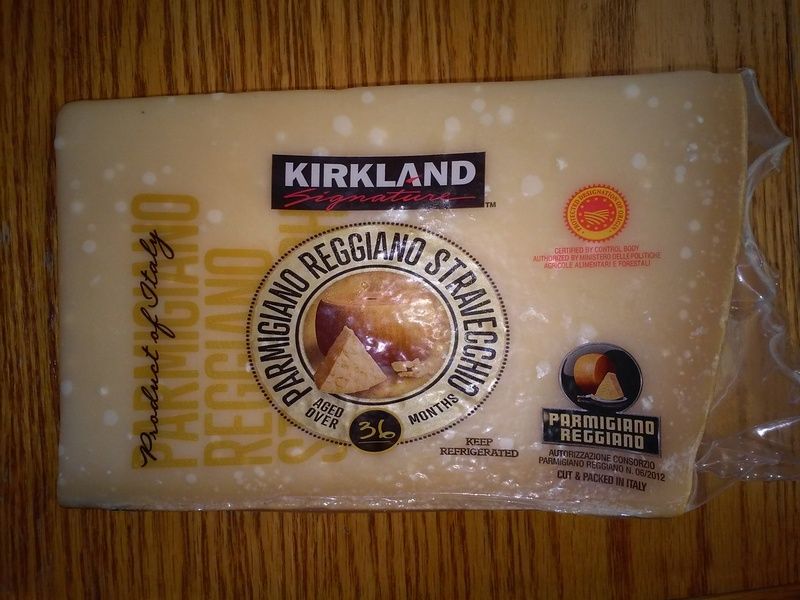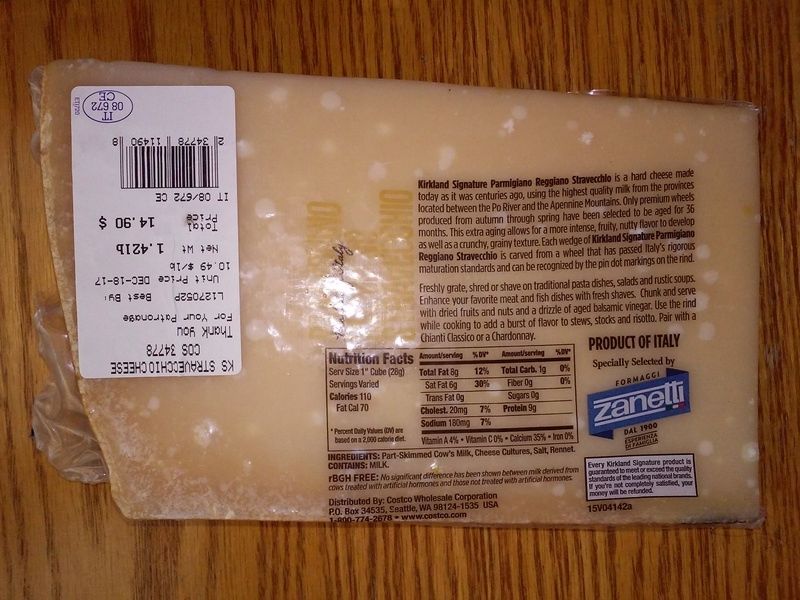Woah, this is a default personal text! Edit your profile to change this to what you like!
Deleted
|
Post by Deleted on May 16, 2017 20:12:55 GMT -5
|
|
Woah, this is a default personal text! Edit your profile to change this to what you like!
Deleted
|
Post by Deleted on May 16, 2017 21:00:39 GMT -5
Graviazi, it does not say it's made with raw part-skimmed milk like the Grana Padano is... What's up with that?
|
|
Woah, this is a default personal text! Edit your profile to change this to what you like!
Administrator
|
Post by Walter on May 16, 2017 22:30:10 GMT -5
Graviazi, it does not say it's made with raw part-skimmed milk like the Grana Padano is... What's up with that? P-R is pretty meticulously regulated, so I'd guess if it is claiming to be P-R its the real deal. Stravecchio means a longer aging, "vecchio" = old. |
|
Woah, this is a default personal text! Edit your profile to change this to what you like!
Someone who needs to post more
|
Post by frmthegrav on May 17, 2017 20:31:53 GMT -5
fred: thats probably a pretty good one.
FYI (from wikipedia):
Aging time Minimum: 12 months
Vecchio: 18–24 months
Stravecchio: 24–36 months
its also supposed to be made with raw milk thats mixed with some skimmed milk.
In 2008, an EU court determined that the name "Parmesan" in Europe only refers to Parmigiano-Reggiano and cannot be used for imitation Parmesan.[11][12][13] Thus, in the European Union, "Parmigiano-Reggiano" is a protected designation of origin (PDO - DOP in Italian); legally, the name refers exclusively to the Parmigiano-Reggiano PDO cheese manufactured in a limited area in northern Italy. Special seals identify the product as authentic, with the identification number of the dairy, the production month and year, a code identifying the individual wheel and stamps regarding the length of aging.[14]
Within the European Union, the term Parmesan may only be used, by law, to refer to Parmigiano-Reggiano itself, which must be made in a restricted geographic area, using stringently defined methods. In many areas outside Europe, the name "Parmesan" has become genericized, and may denote any of a number of hard Italian-style grating cheeses,[17][18] often commercialized under names intended to evoke the original: Parmesan, Parmigiana, Parmesana, Parmabon, Real Parma, Parmezan, Parmezano,[19] Reggianito. After the European ruling that "parmesan" could not be used as a generic name, Kraft renamed its grated cheese "Pamesello" in Europe.
the real parmigiano reggiano will have the words in dot form (like a dot matrix printer) on the rind. thats how youll always know its the real deal.
also:
Grana Padano
Grana Padano is an Italian cheese similar to Parmigiano-Reggiano.
Differences are:
It is produced mainly in Lombardy; "Padano" refers to the Po Valley (Pianura Padana).
Cows can also be fed silage, not grass and hay only.
The milk contains slightly less fat.
Milk of several days can be used.
No organic certifications.[citation needed]
No controlled proceedings over cow breeds.[citation needed]
No cow feed control.[citation needed]
Minimum aging of 9 months.
|
|
Woah, this is a default personal text! Edit your profile to change this to what you like!
Someone who needs to post more
|
Post by frmthegrav on May 17, 2017 20:53:44 GMT -5
from: www.wholefoodsmarket.com/blog/strange-food-trends-raw-milk-cheesesRaw-milk cheeses may be firm, oozy, creamy or crumbly and can come in any shape from wheel to block. Almost always made by small-scale artisanal producers, they often come from single-herd cow, sheep or goat milk. Raw-milk cheeses are not as strange as you may think In fact, I’ll bet you’ve already enjoyed a bite or two of these cheeses. For example, the famous Parmigiano Reggiano, can’t be called Parmigiano Reggiano unless it’s made from raw milk – it’s the law! Many other European cheeses, from those big, beautiful Camemberts to some great triple-crème bries, are required by France’s Appellation d’origine contrôlée (AOC) to use raw milk in their production as well. my opinion here: the milk in italy is heated to about 131 degrees before they separate the curds. it could be that the italians still consider this raw, as it is not pasteurized at that temperature. in the US, i dont think it is considered raw anymore (raw dieters consider foods raw that have been exposed to temperatures below 105 degrees or so; not higher). pasteurization peaks at 250 degrees. thermalized cheese peaks at 140 to 150 degrees. |
|
Woah, this is a default personal text! Edit your profile to change this to what you like!
Deleted
|
Post by Deleted on May 17, 2017 20:54:50 GMT -5
Grazie, stravecchio Graviazi.
|
|
Woah, this is a default personal text! Edit your profile to change this to what you like!
Someone who needs to post more
|
Post by frmthegrav on May 17, 2017 21:27:21 GMT -5
forget the technical details-- how is the cheese?
|
|
Woah, this is a default personal text! Edit your profile to change this to what you like!
Deleted
|
Post by Deleted on May 17, 2017 21:40:08 GMT -5
forget the technical details-- how is the cheese? Magnifico!! Definitely a cut above the Padano but don't get me wrong, the Padano is really good too. You got me hooked on eating this stuff neat by the chunk, Graviazi... |
|









